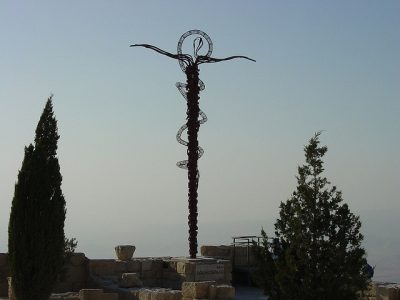It is the place where Moses was buried and the most revered holy site in Jordan.
When atop this mountain, one can see, as Moses did, the vast panorama that encompasses the Jordan River Valley, the Dead Sea, Jericho, and Jerusalem, often referred to as the holy land. Mount Nebo’s first church was built in the late 4th century to mark the site of Moses’ death. It remains a place of pilgrimage for Christians.
Six tombs, from different periods, have been found hollowed out of the rock beneath the mosaic-covered floor of the church. In the present presbytery remnants of mosaics, the earliest of which is a panel with a braided cross, can be seen. The Serpentine Cross, which stands just outside the sanctuary, is symbolic of the brass serpent taken by Moses into the desert and the cross upon wich Jesus was crucified.
The Moses Memorial Church at Mount Nebo displays a large number of beautiful mosaics.

Moses Memorial Church at Mount Nebo is an iconic site that has undergone several restorations to preserve its rich historical legacy. Originally founded in the 4th century by early Christians, the church was expanded in the 6th century to house exquisite mosaics that depict religious scenes and daily life from Byzantine times. These mosaics are exceptionally well-preserved, offering vibrant insights into the past. The church itself serves as a memorial to Moses, celebrating the spot where he is believed to have seen the Promised Land. Visitors are drawn to the spiritual and historical significance of this site, making it a pivotal stop in the exploration of Jordan’s religious heritage.
The Serpentine Cross sculpture at Mount Nebo is a profound symbol that connects biblical history with Christian symbolism. Created by Italian artist Giovanni Fantoni, it merges the image of the bronze serpent Moses created in the wilderness, as described in the Old Testament, with the cross on which Jesus was crucified. This amalgamation represents the sin and suffering of humanity and the hope of salvation. Standing prominently at the top of Mount Nebo, the cross is not only a striking visual piece but also a spiritual beacon that draws visitors into a reflective journey through biblical history and theology.


The Six Tombs at Mount Nebo are an integral part of the site’s archaeological ensemble, providing visitors with a glimpse into the burial practices and religious life of the Byzantine era. These tombs, excavated near Moses Memorial Church, vary in size and architectural design, reflecting the different social statuses of those interred. Some of the tombs are simple, while others are more elaborate, featuring intricate mosaics and inscriptions that offer insights into the beliefs and customs of the period. This diversity in burial styles helps illustrate the historical and cultural stratifications of the ancient communities that lived in the region.
The people of Mount Nebo are part of the larger Jordanian tapestry, known for their hospitality and deep-rooted history. Visitors can enjoy local Jordanian cuisine at nearby restaurants where traditional dishes like mansaf and mezze are served, offering a taste of the region’s culinary heritage.
Mount Nebo provides a profound connection to the past, coupled with breathtaking views and a serene atmosphere, making it a must-visit for those traveling through Jordan.

